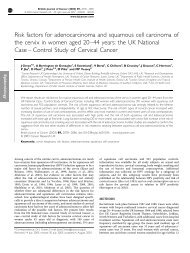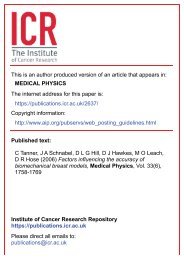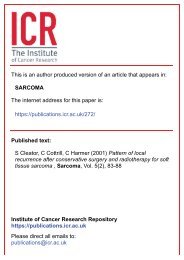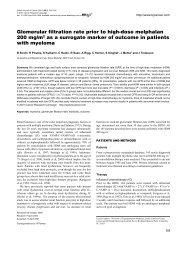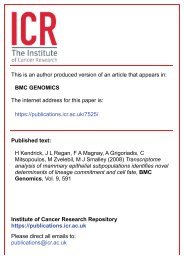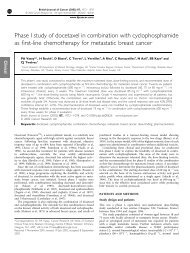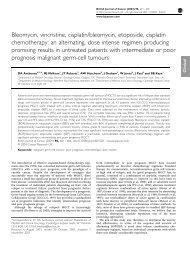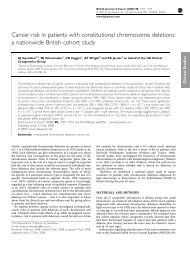The diagnosis and management of pre-invasive breast disease ...
The diagnosis and management of pre-invasive breast disease ...
The diagnosis and management of pre-invasive breast disease ...
Create successful ePaper yourself
Turn your PDF publications into a flip-book with our unique Google optimized e-Paper software.
This is an author produced version <strong>of</strong> an article that appears in:BREAST CANCER RESEARCH<strong>The</strong> internet address for this paper is:https://publications.icr.ac.uk/3708/Published text:P T Simpson, T Gale, L G Fulford, J S Reis-Filho, S R Lakhani(2003) <strong>The</strong> <strong>diagnosis</strong> <strong>and</strong> <strong>management</strong> <strong>of</strong> <strong>pre</strong>-<strong>invasive</strong> <strong>breast</strong><strong>disease</strong> - Pathology <strong>of</strong> atypical lobular hyperplasia <strong>and</strong> lobularcarcinoma in situ, Breast Cancer Research, Vol. 5(5), 258-262Institute <strong>of</strong> Cancer Research Repositoryhttps://publications.icr.ac.ukPlease direct all emails to:publications@icr.ac.uk
Breast Cancer Research Vol 5 No 5 Simpson et al.Review<strong>The</strong> <strong>diagnosis</strong> <strong>and</strong> <strong>management</strong> <strong>of</strong> <strong>pre</strong>-<strong>invasive</strong> <strong>breast</strong> <strong>disease</strong>Pathology <strong>of</strong> atypical lobular hyperplasia <strong>and</strong> lobular carcinomain situPeter T Simpson 1 , <strong>The</strong>odora Gale 1 , Laura G Fulford 1,2 , Jorge S Reis-Filho 1 <strong>and</strong> Sunil R Lakhani 1,31 <strong>The</strong> Breakthrough Toby Robins Breast Cancer Research Centre, Institute <strong>of</strong> Cancer Research, London, UK2 <strong>The</strong> Ludwig Institute for Cancer Research, London, UK3 <strong>The</strong> Royal Marsden Hospital, London, UKCorresponding author: Sunil R Lakhani (e-mail: Sunil.Lakhani@icr.ac.uk)Published: 29 July 2003Breast Cancer Res 2003, 5:258-262 (DOI 10.1186/bcr624)© 2003 BioMed Central Ltd (Print ISSN 1465-5411; Online ISSN 1465-542X)Abstract<strong>The</strong> term lobular neoplasia refers to a spectrum <strong>of</strong> lesions featuring atypical lobular hyperplasia <strong>and</strong>lobular carcinoma in situ (LCIS). <strong>The</strong> histopathological characteristics <strong>of</strong> these lesions are welldocumented. What is less well understood is the <strong>management</strong> implications <strong>of</strong> a patient diagnosed withLCIS; treatment regimes vary <strong>and</strong> are somewhat controversial. LCIS is now considered a risk factor<strong>and</strong> a non-obligate <strong>pre</strong>cursor for the subsequent development <strong>of</strong> <strong>invasive</strong> cancer.Keywords: atypical lobular hyperplasia, <strong>breast</strong> cancer, lobular carcinoma in situ, lobular neoplasia, <strong>pre</strong>cursorlesionIntroductionAtypical lobular hyperplasia (ALH) <strong>and</strong> lobular carcinomain situ (LCIS) – lesions that are also referred to under theumbrella heading <strong>of</strong> ‘lobular neoplasia’ (LN) – occur relativelyinfrequently in the <strong>breast</strong>. However, problems <strong>and</strong>controversies surrounding the most appropriate terminology<strong>and</strong> classification for these lesions, <strong>and</strong> the bestcourse <strong>of</strong> long-term <strong>management</strong> after <strong>diagnosis</strong>, are farfrom infrequent.Foote <strong>and</strong> Stewart first coined the term LCIS in 1941 [1],choosing the name to highlight the morphological similaritiesbetween the cells <strong>of</strong> LCIS <strong>and</strong> those <strong>of</strong> frankly <strong>invasive</strong>lobular carcinoma. <strong>The</strong>y recognised parallels with ductalcarcinoma in situ (DCIS), namely foci <strong>of</strong> neoplastic cellsthat were still contained within a basement membrane. Inanticipating that LCIS, like DCIS, was a step along thepathway to <strong>invasive</strong> cancer, they recommended mastectomyas the st<strong>and</strong>ard form <strong>of</strong> treatment; this <strong>management</strong>plan was adopted for many years. <strong>The</strong> term ALH was subsequentlyintroduced to describe morphologically similarbut less well developed lesions. LN was a term introducedby Haagensen in 1978 [2] to cover the full range <strong>of</strong> proliferation,including both ALH <strong>and</strong> LCIS within the spectrum.ALH <strong>and</strong> LCIS have since become well-establishedhistopathological entities in the classification <strong>of</strong> <strong>breast</strong>neoplasia, but it has become clear over the past 60 yearsthat they are not <strong>pre</strong>cursor lesions for <strong>invasive</strong> carcinomain the same way as high-grade DCIS <strong>of</strong> comedo type[3–6]. A <strong>diagnosis</strong> <strong>of</strong> ALH/LCIS today is <strong>of</strong>ten seen as a‘risk indicator’ for subsequent carcinoma rather than a true<strong>pre</strong>cursor. Radical surgical treatment has fallen out <strong>of</strong>favour but there is a lack <strong>of</strong> consensus on what the mostappropriate <strong>management</strong> <strong>of</strong> patients diagnosed withALH/LCIS should be. Recommendations for treatmentvary from follow-up with regular mammography, to followupalone or simply ‘no action’ [2,7,8]. However, recentwork is once again suggesting that LCIS is indeed a nonobligate<strong>pre</strong>cursor lesion for carcinoma, a finding thatmight have significant implications for the <strong>management</strong> <strong>of</strong>patients diagnosed with this <strong>disease</strong>.258ALH = atypical lobular hyperplasia; DCIS = ductal carcinoma in situ; LCIS = lobular carcinoma in situ; LIN = lobular intraepithelial neoplasia; LN =lobular neoplasia; PLCIS = pleomorphic LCIS.
Available online http://<strong>breast</strong>-cancer-research.com/content/5/5/258Epidemiology <strong>of</strong> LNLCIS is most frequently diagnosed in women agedbetween 40 <strong>and</strong> 50 years (less than 10% <strong>of</strong> patients withLCIS are postmenopausal), which is a decade earlier thanthe age <strong>of</strong> women diagnosed with DCIS. Estimating theincidence <strong>of</strong> LCIS is fraught with difficulty. <strong>The</strong>re are nospecific clinical abnormalities, in particular no palpablelump, <strong>and</strong> LCIS is only rarely visible on mammographywhen an uncommon calcifying subtype is <strong>pre</strong>sent [9,10].When examining a pathological specimen, there are nomacroscopic features characteristic <strong>of</strong> LCIS. <strong>The</strong> <strong>diagnosis</strong><strong>of</strong> LCIS is therefore usually an incidental finding in<strong>breast</strong> biopsy performed for other indications. For thesereasons the true incidence <strong>of</strong> LCIS in the general populationis unknown, <strong>and</strong> many asymptomatic women <strong>pre</strong>sumablygo unnoticed. <strong>The</strong> incidence <strong>of</strong> LCIS in otherwisebenign <strong>breast</strong> biopsy is between 0.5% <strong>and</strong> 3.8% [2,11].Figure 1Characteristically, LCIS is multifocal <strong>and</strong> bilateral in a largeproportion <strong>of</strong> cases. Over 50% <strong>of</strong> patients diagnosed withLN contain multiple foci in the ipsilateral <strong>breast</strong> <strong>and</strong> about30% <strong>of</strong> cases will have further LCIS in the contralateral<strong>breast</strong> [12–14]. This multifocality, in a clinically undetectablelesion, is one <strong>of</strong> the reasons why planning subsequent<strong>management</strong> is so difficult.Histological features <strong>of</strong> LN<strong>The</strong> criteria for the histological <strong>diagnosis</strong> <strong>of</strong> ALH <strong>and</strong> LCISare well established. LCIS is composed <strong>of</strong> a monomorphicpopulation <strong>of</strong> usually small, round, polygonal or cuboidalcells, with a thin rim <strong>of</strong> clear cytoplasm <strong>and</strong> a high nuclearcytoplasmicratio (Fig. 1). Cells containing clear vacuoles,known as intracytoplasmic lumina or magenta bodies, are<strong>of</strong>ten seen, <strong>and</strong> when they are identified in a fine needleaspirate from the <strong>breast</strong>, they strongly suggest the <strong>pre</strong>sence<strong>of</strong> a lobular lesion (including ALH, LCIS <strong>and</strong> <strong>invasive</strong>lobular carcinoma). <strong>The</strong> cells are loosely cohesive, regularlyspaced, <strong>and</strong> fill <strong>and</strong> distend the acini; however, overalllobular architecture is maintained. Gl<strong>and</strong>ular lumina arenot seen, <strong>and</strong> mitoses, calcification <strong>and</strong> necrosis areuncommon. Pagetoid s<strong>pre</strong>ad, in which the neoplastic cellsextend along adjacent ducts, between intact overlyingepithelium <strong>and</strong> underlying basement membrane, is als<strong>of</strong>requently seen.<strong>The</strong> cells <strong>of</strong> classic LCIS, as described above, can also bereferred to as type A cells. Type B cells are a well-recognisedsubtype <strong>of</strong> LCIS cells, with mildly to moderatelylarger nuclei showing some increase in pleomorphism. Amore recently described entity is that <strong>of</strong> pleomorphic LCIS(PLCIS). <strong>The</strong> cells in this lesion show more marked pleomorphism<strong>and</strong> distinctly larger nuclei with nucleoli. Centralnecrosis <strong>and</strong> calcification within lobules are features <strong>of</strong>note. In a situation analogous to ALH versus LCIS, theremight be some difficulty in terminology <strong>and</strong> practical differentiationbetween a case <strong>of</strong> LCIS with type B cells <strong>and</strong>Differentiation <strong>of</strong> atypical lobular hyperplasia from lobular carcinoma insitu is based on the extent <strong>of</strong> proliferation <strong>and</strong> the distension <strong>of</strong> thelobular unit. In this case <strong>of</strong> atypical lobular hyperplasia (upper panel),all acini are filled with neoplastic lobular type A cells (arrows), yet veryfew are distorted. In contrast, the lower panel demonstrates that morethan 50% <strong>of</strong> acini are filled <strong>and</strong> distended, indicating a <strong>diagnosis</strong> <strong>of</strong>lobular carcinoma in situ. Haematoxylin/eosin stain.that <strong>of</strong> PLCIS. Sneige <strong>and</strong> colleagues [15] have describedtype B cells as containing nuclei that are up to double thesize <strong>of</strong> a lymphocyte (type A cells are 1–1.5 times larger),whereas PLCIS nuclei are typically four times larger.<strong>The</strong>se subtypes might re<strong>pre</strong>sent a spectrum <strong>of</strong> lesions,but it is possible that PLCIS has different biological behaviour<strong>and</strong> implications from those <strong>of</strong> classic LCIS. It istherefore important to recognise <strong>and</strong> document the <strong>pre</strong>sence<strong>of</strong> this variant.For a <strong>diagnosis</strong> <strong>of</strong> LCIS, more than half the acini in aninvolved lobular unit must be filled <strong>and</strong> distended by thecharacteristic cells, leaving no central lumina (Fig. 1). For259
Breast Cancer Research Vol 5 No 5 Simpson et al.260practical diagnostic purposes, distension translates aseight or more cells <strong>pre</strong>sent across the diameter <strong>of</strong> anacinus. A lesion is regarded as ALH when it is less welldeveloped <strong>and</strong> less extensive than this, for instance whenthe characteristic cells only partly fill the acini, with no oronly mild distension <strong>of</strong> the lobule (Fig. 1). Lumina mightstill be visible <strong>and</strong> the number <strong>of</strong> acini involved is less thanhalf. Myoepithelial cells can be seen admixed with the neoplasticpopulation.Clearly the differentiation between ALH <strong>and</strong> LCIS onthese criteria is somewhat arbitrary, <strong>and</strong> associated withinter-observer <strong>and</strong> intra-observer variability. <strong>The</strong> use <strong>of</strong> theterm LN to encompass the whole range <strong>of</strong> changes mighttherefore be <strong>pre</strong>ferable for diagnostic purposes. So far theterm has not gained wides<strong>pre</strong>ad use among pathologists.As discussed below, the justification for continuing to usethe ALH/LCIS terminology is that ALH has been shown tohave a lower risk than LCIS <strong>of</strong> subsequent <strong>invasive</strong> carcinoma[11,16,17].A further system for classification <strong>of</strong> these lesions hasbeen proposed by using the terminology ‘lobular intraepithelialneoplasia’ (LIN) <strong>and</strong> with subdivision, based onmorphological criteria <strong>and</strong> clinical outcome, into threegrades: LIN 1, LIN 2 <strong>and</strong> LIN 3 [18]. <strong>The</strong> assertion is thatthe risk <strong>of</strong> subsequent <strong>invasive</strong> carcinoma is related toincreasing grade <strong>of</strong> LIN; however, there is as yet no consensus<strong>of</strong> opinion, <strong>and</strong> data to support this view are <strong>pre</strong>liminary.In view <strong>of</strong> the rapid evolution in technology (seethe review on new technology in this series [19]), the classificationsystems are likely to undergo further change asmolecular data are incorporated. Hence, at <strong>pre</strong>sent, itdoes not seem prudent to introduce yet another interimclassification. We should take a lesson from the multiplelymphoma classifications that led to considerable confusionin patient <strong>management</strong>.Differential <strong>diagnosis</strong> <strong>of</strong> LNOccasional diagnostic difficulty can occur in cases inwhich poor tissue <strong>pre</strong>servation leads to an artefactualappearance <strong>of</strong> discohesive cells within a lobular unit,resulting in an over<strong>diagnosis</strong> <strong>of</strong> LCIS. Another well-recognisedproblem occurs when LCIS is superimposed on atype <strong>of</strong> benign <strong>breast</strong> lesion known as sclerosing adenosis,which causes a distortion <strong>of</strong> lobular units <strong>and</strong> a scleroticstroma. <strong>The</strong> combination <strong>of</strong> abnormal architecture<strong>and</strong> the proliferative lobular cells can easily be mistakenfor an <strong>invasive</strong> carcinoma by the unwary. In this situation,immunohistochemistry to demonstrate the myoepithelialcell layer or basement membrane can be useful in makingthe distinction.<strong>The</strong> most important, <strong>and</strong> the most difficult, differential <strong>diagnosis</strong><strong>of</strong> LCIS is from low-nuclear-grade, solid DCIS. Thisentity carries wholly different <strong>management</strong> implications forthe patient because it usually requires surgical excision,whereas arguably, as discussed, LCIS might warrant n<strong>of</strong>urther action. Correct identification is therefore essential.However, distinction <strong>of</strong> LCIS from low-grade solid DCIScan be very difficult because morphologically they can bestrikingly similar (Fig. 2), especially when DCIS involves theacini with minimal or no lobular distortion. <strong>The</strong> <strong>pre</strong>sence <strong>of</strong>secondary lumen formation <strong>and</strong> cellular cohesion mightpoint to a ductal lesion rather than LCIS. Immunohistochemicalanalysis <strong>of</strong> the lesion can prove useful becauseE-cadherin, a cell membrane molecule involved in celladhesion, is typically absent in ALH/LCIS but <strong>pre</strong>sent inDCIS (see the review on molecular genetics in this series[20]). In addition the ex<strong>pre</strong>ssion <strong>of</strong> high-molecular-masscytokeratin (CK34βE12) is usually seen in LCIS but not inDCIS [21]. Occasionally, lesions show a combination <strong>of</strong>markers, suggesting that LCIS <strong>and</strong> low-grade solid DCIScan coexist within the same duct-lobular unit. In these circumstances,differentiation between the two is <strong>of</strong>ten notpossible <strong>and</strong> both diagnoses should be given.Implications <strong>of</strong> LNAlthough it is clear that LCIS is not an obligate <strong>pre</strong>cursorto <strong>invasive</strong> lobular carcinoma, many studies have shownthat a proportion <strong>of</strong> women with LCIS go on to develop<strong>invasive</strong> carcinoma, with a risk <strong>of</strong> 6.9 times to about 12times that <strong>of</strong> women without LCIS [2,22].Page <strong>and</strong> colleagues [11,16] reported that the relative risk<strong>of</strong> subsequently developing <strong>breast</strong> cancer was different inpatients diagnosed with ALH compared with LCIS.Patients diagnosed with ALH have a risk <strong>of</strong> 4–5 times that<strong>of</strong> the general population (namely women, <strong>of</strong> comparableage, who have had a <strong>breast</strong> biopsy performed with no<strong>diagnosis</strong> <strong>of</strong> proliferative <strong>disease</strong>) [16,17]. This relativerisk is doubled to 8–10 times for LCIS [11]. Thus,although LN is a helpful term for describing these lesionscollectively, classification into ALH <strong>and</strong> LCIS might still bejustified, or <strong>pre</strong>ferable for risk stratification <strong>and</strong> <strong>management</strong>decisions.Data accumulated from nine separate studies revealedthat 15% <strong>of</strong> 172 patients diagnosed with LCIS developed<strong>invasive</strong> carcinoma in the ipsilateral <strong>breast</strong>, <strong>and</strong> 9.3% <strong>of</strong>204 patients developed <strong>invasive</strong> carcinoma in the contralateral<strong>breast</strong> [23]. <strong>The</strong> development <strong>of</strong> contralateral<strong>breast</strong> cancer is three times more likely in patients diagnosedwith LCIS than without LCIS [24]. <strong>The</strong> risk <strong>of</strong> developing<strong>breast</strong> cancer is therefore also bilateral [12].Reports have suggested that this risk is equal to both<strong>breast</strong>s; however, corroborating studies demonstrate thatcarcinoma is three times more likely to develop in the ipsilateralrelative to the contralateral <strong>breast</strong> [16,25,26].<strong>The</strong> time taken to develop <strong>invasive</strong> cancer after <strong>diagnosis</strong><strong>of</strong> LCIS is unclear. Page <strong>and</strong> colleagues [11] reported that
Available online http://<strong>breast</strong>-cancer-research.com/content/5/5/258Figure 2Differential <strong>diagnosis</strong> is <strong>of</strong>ten difficult between lobular carcinoma in situ (arrow in upper left panel) <strong>and</strong> low-nuclear-grade, solid ductal carcinoma insitu (upper right panel). Both lesions exhibit characteristic small monomorphic cells with a high nuclear-cytoplasmic ratio (high-power views, lowermiddle <strong>and</strong> lower right panels, respectively). In contrast, high-grade ductal carcinoma in situ (arrowhead in upper left panel; high-power view, lowerleft panel) exhibits markedly different histopathological features, notably the cohesiveness <strong>of</strong> neoplastic cells, pleomorphic nuclei <strong>and</strong> abundanteosinophilic-to-amphiphilic cytoplasm. Haematoxylin/eosin stain.two-thirds <strong>of</strong> women who developed <strong>invasive</strong> cancer didso within 15 years <strong>of</strong> biopsy, yet in a separate study over50% <strong>of</strong> cases who developed cancer did so between 15<strong>and</strong> 30 years after biopsy, with an average interval <strong>of</strong> 20.4years [27].Both <strong>invasive</strong> ductal carcinoma <strong>and</strong> <strong>invasive</strong> lobular carcinomaoccur with LCIS. <strong>The</strong> coexistence <strong>of</strong> DCIS <strong>and</strong>LCIS might explain the <strong>invasive</strong> ductal carcinoma componentobserved, by which DCIS <strong>and</strong> not LCIS is the likely<strong>pre</strong>cursor lesion [28,29]. Evidence for the role <strong>of</strong> LCIS asa <strong>pre</strong>cursor for <strong>invasive</strong> lobular carcinoma is supported bythe epidemiological data outlined above, the morphologicalsimilarity between cells <strong>of</strong> ALH/LCIS <strong>and</strong> lobular carcinoma<strong>and</strong> the development <strong>of</strong> tumours in regions localisedto ALH/LCIS. Work on molecular aspects <strong>of</strong> lobularlesions, in particular that focusing on the marker E-cadherin,add to this view (see the review on molecular geneticsin this series [20]).Thus, the evidence, that 10–20% <strong>of</strong> patients identifiedwith LCIS develop <strong>breast</strong> carcinoma in the 15–25 yearsafter initial <strong>diagnosis</strong>, is compelling. Identifying this subgroup<strong>of</strong> individuals is not easy by current clinical or morphologicalmeans, although both morphologicalclassifications <strong>and</strong> the use <strong>of</strong> E-cadherin have been suggested.Clearly further characterisation <strong>of</strong> these smalllesions is necessary to disentangle the current problemsfaced in classification <strong>and</strong> <strong>management</strong>. It is hoped thatThis article is the third in a review series on<strong>The</strong> <strong>diagnosis</strong> <strong>and</strong> <strong>management</strong> <strong>of</strong> <strong>pre</strong>-<strong>invasive</strong> <strong>breast</strong><strong>disease</strong> — current challenges, future hopes, edited bySunil R Lakhani.Other articles in the series can be found athttp://<strong>breast</strong>-cancer-research.com/articles/reviewseries.asp?series=bcr_<strong>The</strong><strong>diagnosis</strong>261
Breast Cancer Research Vol 5 No 5 Simpson et al.262the application <strong>of</strong> microdissection techniques <strong>and</strong> recentlydeveloped molecular technology will hold the key to ourfuture underst<strong>and</strong>ing <strong>of</strong> LN.Competing interestsNone declared.References1. Foote FW Jr, Stewart FW: Lobular carcinoma in situ. A rareform <strong>of</strong> mammary cancer. Am J Pathol 1941, 17:491-496.2. Haagensen CD, Lane N, Lattes R, Bodian C: Lobular neoplasia(so-called lobular carcinoma in situ) <strong>of</strong> the <strong>breast</strong>. Cancer1978, 42:737-769.3. Goldstein NS, Vicini FA, Kestin LL, Thomas M: Differences in thepathologic features <strong>of</strong> ductal carcinoma in situ <strong>of</strong> the <strong>breast</strong>based on patient age. Cancer 2000, 88:2553-2560.4. Ringberg A, Idvall I, Ferno M, Anderson H, Anagnostaki L, BoiesenP, Bondesson L, Holm E, Johansson S, Lindholm K, Ljungberg O,Ostberg G: Ipsilateral local recurrence in relation to therapy<strong>and</strong> morphological characteristics in patients with ductal carcinomain situ <strong>of</strong> the <strong>breast</strong>. Eur J Surg Oncol 2000, 26:444-451.5. Silverstein MJ, Poller DN, Waisman JR, Colburn WJ, Barth A,Gierson ED, Lewinsky B, Gamagami P, Slamon DJ: Prognosticclassification <strong>of</strong> <strong>breast</strong> ductal carcinoma-in-situ. Lancet 1995,345:1154-1157.6. Skinner KA, Silverstein MJ: <strong>The</strong> <strong>management</strong> <strong>of</strong> ductal carcinomain situ <strong>of</strong> the <strong>breast</strong>. Endocr Relat Cancer 2001, 8:33-45.7. Wheeler JE, Enterline HT, Roseman JM, Tomasulo JP, McIlvaineCH, Fitts WT, Jr., Kirshenbaum J: Lobular carcinoma in situ <strong>of</strong>the <strong>breast</strong>. Long-term followup. Cancer 1974, 34:554-563.8. Wheeler JE, Enterline HT: Lobular carcinoma <strong>of</strong> the <strong>breast</strong> insitu <strong>and</strong> infiltrating. Pathol Annu 1976, 11:161-188.9. Sapino A, Frigerio A, Peterse JL, Arisio R, Coluccia C, BussolatiG: Mammographically detected in situ lobular carcinomas <strong>of</strong>the <strong>breast</strong>. Virchows Arch 2000, 436:421-430.10. Georgian-Smith D, Lawton TJ: Calcifications <strong>of</strong> lobular carcinomain situ <strong>of</strong> the <strong>breast</strong>: radiologic–pathologic correlation.AJR Am J Roentgenol 2001, 176:1255-1259.11. Page DL, Kidd TJ, Dupont WD, Simpson JF, Rogers LW: Lobularneoplasia <strong>of</strong> the <strong>breast</strong>: higher risk for subsequent <strong>invasive</strong>cancer <strong>pre</strong>dicted by more extensive <strong>disease</strong>. Hum Pathol1991, 22:1232-1239.12. Urban JA: Bilaterality <strong>of</strong> cancer <strong>of</strong> the <strong>breast</strong>. Biopsy <strong>of</strong> theopposite <strong>breast</strong>. Cancer 1967, 20:1867-1870.13. Rosen PP, Senie R, Schottenfeld D, Ashikari R: Non<strong>invasive</strong><strong>breast</strong> carcinoma: frequency <strong>of</strong> unsuspected invasion <strong>and</strong>implications for treatment. Ann Surg 1979, 189:377-382.14. Rosen PP, Braun DW Jr, Lyngholm B, Urban JA, Kinne DW:Lobular carcinoma in situ <strong>of</strong> the <strong>breast</strong>: <strong>pre</strong>liminary results <strong>of</strong>treatment by ipsilateral mastectomy <strong>and</strong> contralateral <strong>breast</strong>biopsy. Cancer 1981, 47:813-819.15. Sneige N, Wang J, Baker BA, Krishnamurthy S, Middleton LP:Clinical, histopathologic, <strong>and</strong> biologic features <strong>of</strong> pleomorphiclobular (ductal-lobular) carcinoma in situ <strong>of</strong> the <strong>breast</strong>: areport <strong>of</strong> 24 cases. Mod Pathol 2002, 15:1044-1050.16. Page DL, Dupont WD, Rogers LW, Rados MS: Atypical hyperplasticlesions <strong>of</strong> the female <strong>breast</strong>. A long-term follow-upstudy. Cancer 1985, 55:2698-2708.17. Dupont WD, Page DL: Risk factors for <strong>breast</strong> cancer in womenwith proliferative <strong>breast</strong> <strong>disease</strong>. N Engl J Med 1985, 312:146-151.18. Tavassoli FA: Pathology <strong>of</strong> the <strong>breast</strong>, edn 2. Norwalk, CT: Appleton<strong>and</strong> Lange; 1999.19. Jeffrey SS, Pollack JR: <strong>The</strong> <strong>diagnosis</strong> <strong>and</strong> <strong>management</strong> <strong>of</strong> <strong>pre</strong><strong>invasive</strong><strong>breast</strong> <strong>disease</strong>: <strong>The</strong> promise <strong>of</strong> new technology inunderst<strong>and</strong>ing <strong>pre</strong>-<strong>invasive</strong> lesions. Breast Cancer Res 2003,5: in <strong>pre</strong>ss.20. Reis-Filho JS, Lakhani SR: <strong>The</strong> <strong>diagnosis</strong> <strong>and</strong> <strong>management</strong> <strong>of</strong><strong>pre</strong>-<strong>invasive</strong> <strong>breast</strong> <strong>disease</strong>: Genetic alterations in <strong>pre</strong><strong>invasive</strong>lesions. Breast Cancer Res 2003, 5: in <strong>pre</strong>ss.21. Bratthauer GL, Moinfar F, Stamatakos MD, Mezzetti TP, ShekitkaKM, Man YG, Tavassoli FA: Combined E-cadherin <strong>and</strong> highmolecular weight cytokeratin immunopr<strong>of</strong>ile differentiateslobular, ductal, <strong>and</strong> hybrid mammary intraepithelial neoplasias.Hum Pathol 2002, 33:620-627.22. Andersen JA: Lobular carcinoma in situ. A long-term follow-upin 52 cases. Acta Pathol Microbiol Sc<strong>and</strong> [A] 1974, 82:519-533.23. Andersen JA: Lobular carcinoma in situ <strong>of</strong> the <strong>breast</strong>. Anapproach to rational treatment. Cancer 1977, 39:2597-2602.24. Haagensen CD, Lane N, Bodian C: Coexisting lobular neoplasia<strong>and</strong> carcinoma <strong>of</strong> the <strong>breast</strong>. Cancer 1983, 51:1468-1482.25. Marshall LM, Hunter DJ, Connolly JL, Schnitt SJ, Byrne C, LondonSJ, Colditz GA: Risk <strong>of</strong> <strong>breast</strong> cancer associated with atypicalhyperplasia <strong>of</strong> lobular <strong>and</strong> ductal types. Cancer Epidemiol BiomarkersPrev 1997, 6:297-301.26. Page DL, Schuyler PA, Dupont WD, Jensen RA, Plummer WD Jr,Simpson JF: Atypical lobular hyperplasia as a unilateral <strong>pre</strong>dictor<strong>of</strong> <strong>breast</strong> cancer risk: a retrospective cohort study. Lancet2003, 361:125-129.27. Rosen PP, Kosl<strong>of</strong>f C, Lieberman PH, Adair F, Braun DW Jr:Lobular carcinoma in situ <strong>of</strong> the <strong>breast</strong>. Detailed analysis <strong>of</strong>99 patients with average follow-up <strong>of</strong> 24 years. Am J SurgPathol 1978, 2:225-251.28. Maluf H, Koerner F: Lobular carcinoma in situ <strong>and</strong> infiltratingductal carcinoma: frequent <strong>pre</strong>sence <strong>of</strong> DCIS as a <strong>pre</strong>cursorlesion. Int J Surg Pathol 2001, 9:127-131.29. Rosen PP: Coexistent lobular carcinoma in situ <strong>and</strong> intraductalcarcinoma in a single lobular-duct unit. Am J Surg Pathol1980, 4:241-246.CorrespondenceSunil R Lakhani, <strong>The</strong> Breakthrough Toby Robins Breast CancerResearch Centre, Institute <strong>of</strong> Cancer Research, London SW3 6JB, UK.Tel: +44 20 7153 5167; fax: +44 20 7153 5533; e-mail:Sunil. Lakhani@icr.ac.uk




